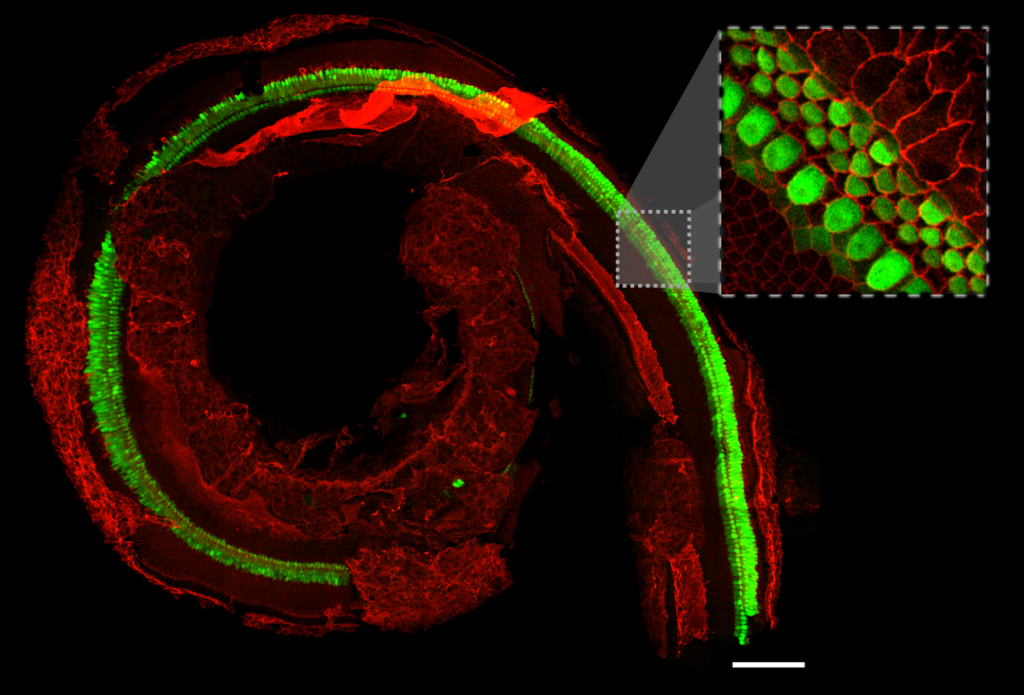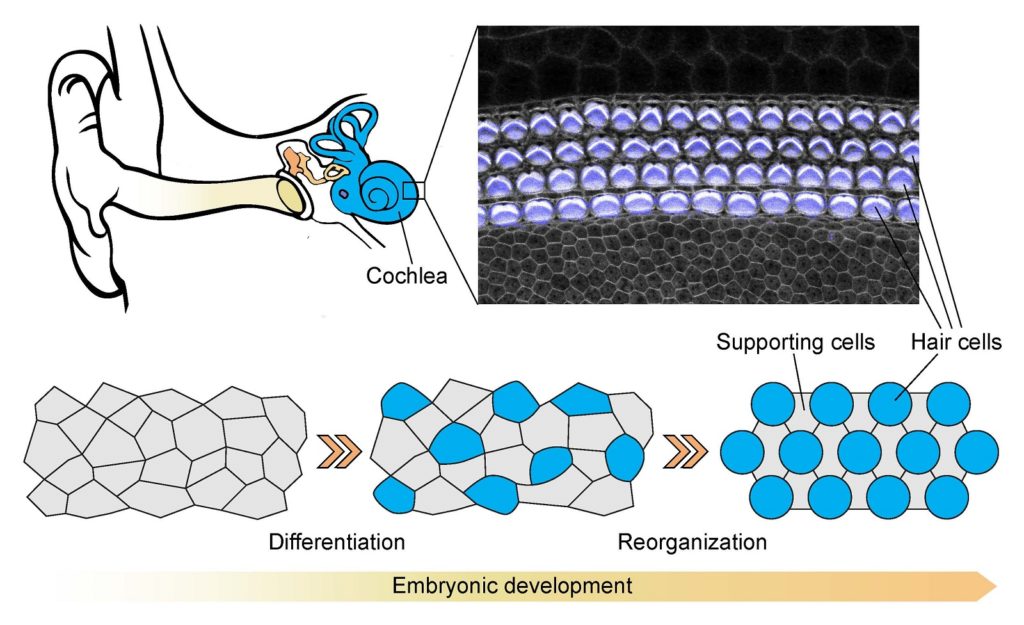Researchers use live tissue confocal microscopy to understand the development of inner ear hair cells
Almost every cell in our body contains the same genetic information; yet we develop into complex organisms with each cell having a unique identity and working successfully within its community to create functional organs and complex systems.

Dr. David Sprinzak of Tel Aviv University (Israel) is interested in how complex, yet precise, cellular patterns emerge during embryonic development. His group focuses on developmental patterns where neighboring cells adopt different fates. One example they use is the pattern of hair cells in the mammalian inner ear, which he describes as a perfect checkerboard-like lattice that emerges during development.
We spoke to Dr. Sprinzak about his recent publication which used confocal microscopy time-lapse imaging to study hair cell rearrangement during development.
What did you focus on in your recent publication?
We looked at the development of the mammalian hearing organ, the organ of Corti. The organ of Corti has four rows of sensory hair cells (the cells that respond to sound vibrations) interspersed by non-sensory cells called supporting cells. This checkerboard-like pattern of hair cells and supporting cells emerge from an initially disordered, undifferentiated epithelium within a few days during embryonic development. We wanted to understand how such a precise cellular pattern emerges during embryonic development.

Confocal image of the entire sensory epithelium from an E16.5 cochlea. Cellular boundaries and hair cells are marked with Cy3 and EGFP fluorescent markers, respectively. The image is a maximum intensity projection of stitched optically sectioned tiles. A single z-plane zoomed-in region is shown in the gray box. The image was taken with a ZEISS LSM 880 confocal with Airyscan detector using a 63x oil-immersion objective. Scale bar: 100 microns.
What were your key findings?
What we found was that initially some of the cells differentiate into hair cells and others to supporting cells in a disordered ‘salt-and-pepper’ fashion. Then, the cells dynamically rearrange into the precise pattern through a series of local reorganization processes.

Embryonic development of the organ of Corti. Upper right image is a neonatal organ of Corti stained with a fluorescent marker for actin. Hair cells and stereocilia are artificially marked in cyan and white respectively. The image shows the final pattern of hair cells and supporting cells in the organ of Corti. The image was taken with a ZEISS confocal using a 63x oil-immersion objective.
How did you use live cell confocal microscopy in your publication?
To study the dynamics of the inner ear development, we developed a novel platform that allowed us to perform high resolution 4D imaging of inner ear explants. In this assay, dissected inner ear explants from transgenic mouse embryos were imaged in a confocal microscope over 12-24 hours. We used the Airyscan mode to track the cellular dynamics of mouse inner ears at high resolution.
E17.5 organ of Corti from the mid region of the cochlea. Cellular boundaries are marked with EGFP fluorescent marker. The movie demonstrates the relative motion between different cellular layers in the organ of Corti. Each frame was optically sectioned (z-stack) and projected using maximum intensity projection. The movie was taken using a ZEISS LSM 880 confocal with the Airyscan detector using a 40x water-immersion objective. Scale bar: 20 microns.
We also combined microscopy with laser ablation which allowed us to understand the different mechanical properties of the cells. Using a combination of live cell imaging and mathematical modeling, we showed that this gradual organization occurs due to external shear forces that drive the organization of the hair cells into a compact, crystal-like state. Thus, the emergence of a precise pattern of hairs cells is driven by mechanical forces in a process similar to crystallization of atoms in physics.
Laser ablation of cells in an E17.5 organ of Corti. The ablation point is marked with a red ‘x’. Cellular boundaries are marked with EGFP fluorescent marker. Each frame was optically sectioned (z-stack) and projected using maximum intensity projection. The movie was taken with a ZEISS LSM 880 confocal using the Airyscan detector with a 40x water-immersion objective. UV pulse ablation was done using Rapp OptoElectronic UGA-42 Caliburn system, integrated with the ZEISS confocal hardware and software. Scale bar: 10 microns.
The surprising finding was that the organization of hair cells was driven by mechanical forces rather than by molecular signaling as previously thought. It was really nice to find out that the process we found in developmental biology was similar to a classical physical process called shear-induced crystallization.
Learn More
Read the full article: “Mechanical forces drive ordered patterning of hair cells in the mammalian inner ear” Link
Learn more about ZEISS confocal microscopy solutions.





